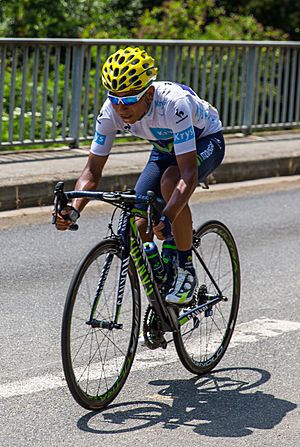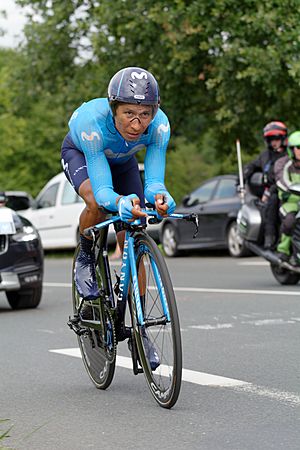Nairo Quintana facts for kids

Quintana at the 2019 Paris–Nice
|
|||
| Personal information | |||
|---|---|---|---|
| Full name | Nairo Alexander Quintana Rojas | ||
| Nickname |
|
||
| Born | 4 February 1990 Cómbita, Boyacá, Colombia |
||
| Height | 1.67 m (5 ft 5+1⁄2 in) | ||
| Weight | 58 kg (128 lb; 9 st 2 lb) | ||
| Team information | |||
| Current team | Movistar Team | ||
| Discipline | Road | ||
| Role | Rider | ||
| Rider type | Climber | ||
| Major wins | |||
|
|||
Nairo Alexánder Quintana Rojas (born February 4, 1990) is a famous Colombian racing cyclist. He is known for being a strong climber, especially on steep hills. He can also ride well in time trials. Nairo is currently part of the UCI WorldTeam Movistar Team.
People call him "Nairoman" or "El Cóndor de los Andes" (The Condor of the Andes). He is one of the most successful cyclists from Colombia. He won the 2014 Giro d'Italia and the 2016 Vuelta a España. He also finished second twice in the Tour de France (in 2013 and 2015). His brother, Dayer Quintana, is also a professional cyclist.
Contents
Nairo Quintana's Early Life
Nairo Quintana was born in Cómbita, a town in Colombia. His family were farmers and did not have much money. They bought Nairo a used mountain bike. He used it to ride 16 kilometers to school through the Andes mountains. He also used it to sell fruits and vegetables in different villages.
When he was 15, a taxi hit him while he was riding his bike. He was in a coma for five days. Even after this, his father, who loved cycling, saw Nairo's talent. He spent money to buy Nairo a racing bike. He wanted to see if Nairo could become a professional cyclist.
Nairo Quintana's Cycling Career
Starting His Journey
Nairo began his cycling career with a team called "Boyacá es para Vivirla". In 2010, he won the Tour de l'Avenir. This race is for young, promising cyclists. His win showed that he was a great talent for the future of Colombian cycling.
Joining Movistar Team (2012–2019)
First Wins in Europe
In 2012, Nairo moved to Europe to join the Spanish Movistar Team team. He quickly won the overall race at the Vuelta a Murcia. He also won a stage at the Critérium du Dauphiné. He then won the Route du Sud. Nairo rode in his first Grand Tour, the Vuelta a España. He helped his teammate Alejandro Valverde finish second. In October, Nairo won the Giro dell'Emilia.
Big Success in 2013
In 2013, Nairo won a stage at the Volta a Catalunya. The next month, he won a tough mountain stage at the Tour of the Basque Country. He then won the overall race after a strong performance in the final time trial.
At the Tour de France, Nairo showed his climbing skills. He attacked on mountain stages and finished second overall. This was a historic result for a Colombian cyclist. He also won the young rider and mountains classifications. After the Tour, he won the Vuelta a Burgos.
Winning the Giro d'Italia in 2014
Nairo decided to focus on the Giro d'Italia in 2014. He started the season by winning the Tour de San Luis. He then finished second at Tirreno–Adriatico.
At the Giro, Nairo was not feeling his best at first. But he got stronger in the last week. On Stage 16, he took the overall lead (the pink jersey) after a challenging stage with fog and a tough descent. He won the stage and gained a lot of time. He also won a mountain time trial on Stage 19. Nairo kept his lead and won the 2014 Giro d'Italia. He also won the white jersey for the best young rider.
After the Giro, Nairo aimed for the Vuelta a España. He won the Vuelta a Burgos before the Vuelta. In the Vuelta, he crashed twice and had to leave the race because of a broken collarbone.
Tour de France Runner-Up in 2015
Nairo started 2015 by finishing third at the Tour de San Luis. He then won the Tirreno–Adriatico after a strong climb in a snowstorm.
At the Tour de France, Nairo lost some time early on. But he fought hard in the mountains. He attacked race leader Chris Froome multiple times in the final week. Nairo finished second overall, just 1 minute and 12 seconds behind Froome. He also won the white jersey for the best young rider again. His team, Movistar Team, won the team classification.
Later in 2015, Nairo rode the Vuelta a España. He was not feeling well at first but improved as the race went on. He finished fourth overall.
Winning the Vuelta a España in 2016
In 2016, Nairo planned to race both the Tour de France and the Vuelta a España. He started the season with a third-place finish at the Tour de San Luis. He then won the overall classification at the Volta a Catalunya.
Nairo finished third in the Tour de France. He then focused on the Vuelta a España. He won the Vuelta ahead of Chris Froome. On Stage 15, Nairo and Alberto Contador attacked early and gained a big lead. Even though Froome fought back in a time trial, Nairo held on to his lead. He became the second Colombian to win the Vuelta.
Aiming for Two Grand Tours in 2017
In 2017, Nairo tried to win both the Giro d'Italia and the Tour de France. In March, he won Tirreno–Adriatico for the second time.
At the Giro d'Italia, Nairo won Stage 9 and took the pink jersey. However, he lost time in the individual time trial on Stage 10. He fought hard in the mountains and regained the pink jersey on Stage 19. But in the final time trial on Stage 21, Tom Dumoulin overtook him. Nairo finished second overall.
Nairo then rode the Tour de France. He struggled and lost a lot of time in the mountains. He finished 12th overall, showing that winning both Grand Tours in one year was very difficult.
2018 Season Highlights
Nairo's main goal for 2018 was the Tour de France. He finished second in the Colombia Oro y Paz race. He also finished second overall at Volta a Catalunya. At the Tour de Suisse, Nairo won a stage with a strong attack and finished third overall.
In the Tour de France, Nairo had some bad luck early on, losing time due to a puncture. He later won Stage 17 with a powerful attack on the final climb. He finished 10th overall in the Tour.
He also rode the Vuelta a España. He started strong but his form dropped in the third week. He finished 8th overall.
2019 Season
In 2019, Nairo won a stage at the Tour Colombia. He also had a great performance at Paris–Nice, finishing second overall. He attacked on the final stage and almost took the lead.
At the Tour de France, Nairo won Stage 18 with another impressive mountain attack. He finished 8th overall. He also finished 4th overall at the Vuelta a España, winning Stage 2 and holding the red jersey for a day.
Arkéa–Samsic (2020–2022)
In September 2019, Nairo, his brother Dayer, and teammate Winner Anacona moved to the Arkéa–Samsic team for the 2020 season.
2020 and 2021 Seasons
In 2020, Nairo won the overall classification at the Tour de la Provence and the Tour des Alpes-Maritimes et du Var. He finished 17th overall in the Tour de France.
In 2021, Nairo won a stage and the overall classification at the Vuelta a Asturias. He rode the Tour de France and wore the polka dot jersey as the mountains classification leader for five stages.
2022 Season and Disqualification
In February 2022, Nairo won two French stage races: the Tour des Alpes-Maritimes et du Var and the Tour de la Provence. He also had top-five finishes at Paris–Nice and the Volta a Catalunya.
Nairo participated in the Tour de France and finished sixth overall. However, his result was later removed by the Union Cycliste Internationale (UCI). This was because he had tested positive for tramadol use. At that time, tramadol was not allowed by the UCI for medical reasons, but it was not a banned substance under other rules. Nairo appealed the decision, but it was upheld. He did not receive a competition ban.
On October 1, 2022, Nairo announced he had left the Arkéa–Samsic team.
Free Agent and Return to Movistar (2023–)
In February 2023, Nairo finished third in the Colombian National Road Race Championships.
Nairo rejoined the Movistar team in October 2023. In May 2024, he rode the 2024 Giro d'Italia, finishing 19th overall and earning two combativity awards for his fighting spirit. In May 2025, he again took part in the 2025 Giro d'Italia, where he received another combativity award on Stage 11 and finished 25th in the general classification.
Nairo Quintana's Major Achievements
Nairo Quintana has achieved many great results in his career. Here are some of his most important wins and high finishes:
- Grand Tours:
- Giro d'Italia: Overall winner in 2014.
- Vuelta a España: Overall winner in 2016.
- Tour de France: Second place in 2013 and 2015, third place in 2016.
- Other Major Stage Races:
- Tour of the Basque Country: Overall winner in 2013.
- Volta a Catalunya: Overall winner in 2016.
- Tour de Romandie: Overall winner in 2016.
- Tirreno–Adriatico: Overall winner in 2015 and 2017.
- Vuelta a Burgos: Overall winner in 2013 and 2014.
- Tour de la Provence: Overall winner in 2020 and 2022.
- Tour des Alpes-Maritimes et du Var: Overall winner in 2020 and 2022.
Awards and Recognition
Nairo Quintana was named the Colombian athlete of the year in both 2013 and 2014. This shows how important he is to sports in his home country.
Images for kids
See also
 In Spanish: Nairo Quintana para niños
In Spanish: Nairo Quintana para niños
















